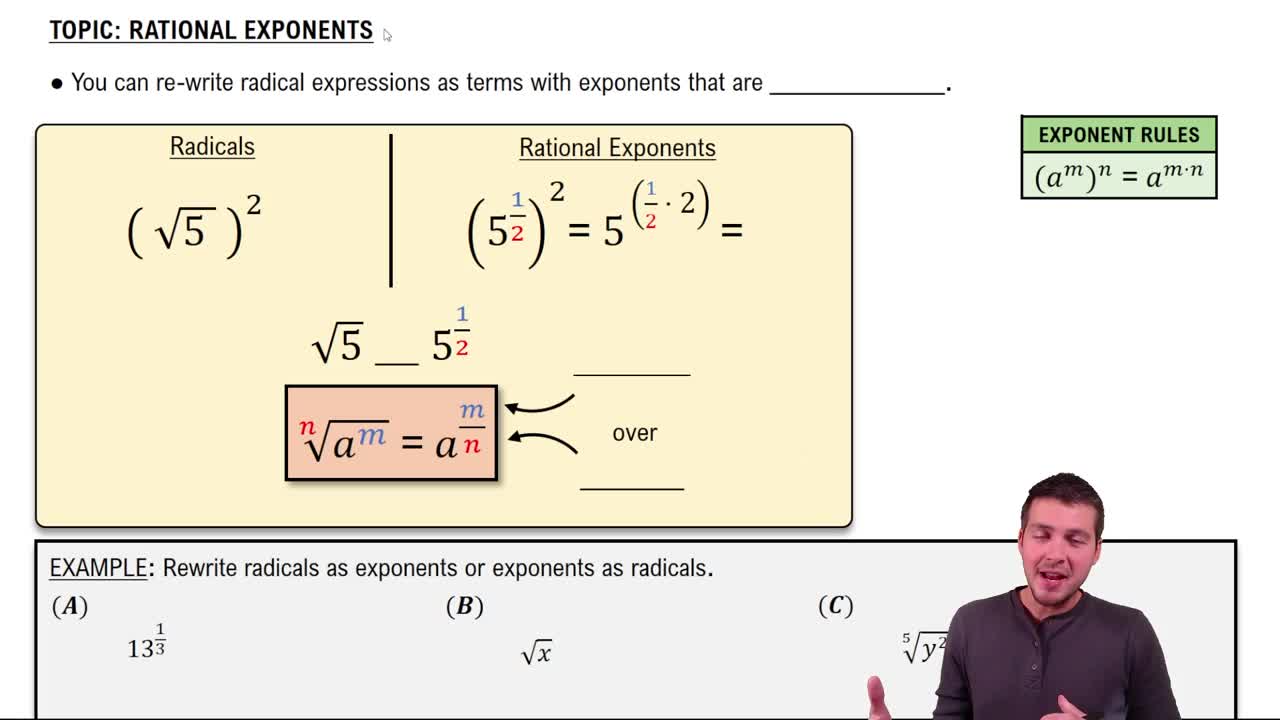Table of contents
- 0. Review of Algebra4h 16m
- 1. Equations & Inequalities3h 18m
- 2. Graphs of Equations43m
- 3. Functions2h 17m
- 4. Polynomial Functions1h 44m
- 5. Rational Functions1h 23m
- 6. Exponential & Logarithmic Functions2h 28m
- 7. Systems of Equations & Matrices4h 6m
- 8. Conic Sections2h 23m
- 9. Sequences, Series, & Induction1h 19m
- 10. Combinatorics & Probability1h 45m
0. Review of Algebra
Exponents
Problem 63c
Textbook Question
Evaluate each expression 16^(1/2)
 Verified step by step guidance
Verified step by step guidance1
Identify the expression: You need to evaluate \(16^{1/2}\).
Recognize that the expression \(16^{1/2}\) represents the square root of 16.
Recall that the square root of a number \(a\) is a value \(b\) such that \(b^2 = a\).
Determine which number squared equals 16. Consider the positive and negative roots.
Conclude that the principal square root of 16 is the positive number that satisfies the equation.
Recommended similar problem, with video answer:
 Verified Solution
Verified SolutionThis video solution was recommended by our tutors as helpful for the problem above
Video duration:
59sPlay a video:
Was this helpful?
Key Concepts
Here are the essential concepts you must grasp in order to answer the question correctly.
Exponents and Radicals
Exponents represent repeated multiplication of a base number. The expression 16^(1/2) indicates the square root of 16, which is a fundamental concept in algebra. Understanding how to manipulate exponents and their relationship to roots is essential for evaluating expressions involving fractional exponents.
Recommended video:
Guided course

Rational Exponents
Square Roots
The square root of a number is a value that, when multiplied by itself, gives the original number. For example, the square root of 16 is 4, since 4 * 4 = 16. Recognizing perfect squares and their roots is crucial for simplifying expressions and solving equations in algebra.
Recommended video:

Imaginary Roots with the Square Root Property
Properties of Exponents
The properties of exponents, such as the product of powers and power of a power, help simplify expressions involving exponents. In the case of fractional exponents, understanding that a^(m/n) equals the n-th root of a raised to the m-th power is vital for evaluating expressions like 16^(1/2). This knowledge allows for efficient computation and manipulation of algebraic expressions.
Recommended video:
Guided course

Rational Exponents

 7:39m
7:39mWatch next
Master Introduction to Exponent Rules with a bite sized video explanation from Patrick Ford
Start learningRelated Videos
Related Practice













